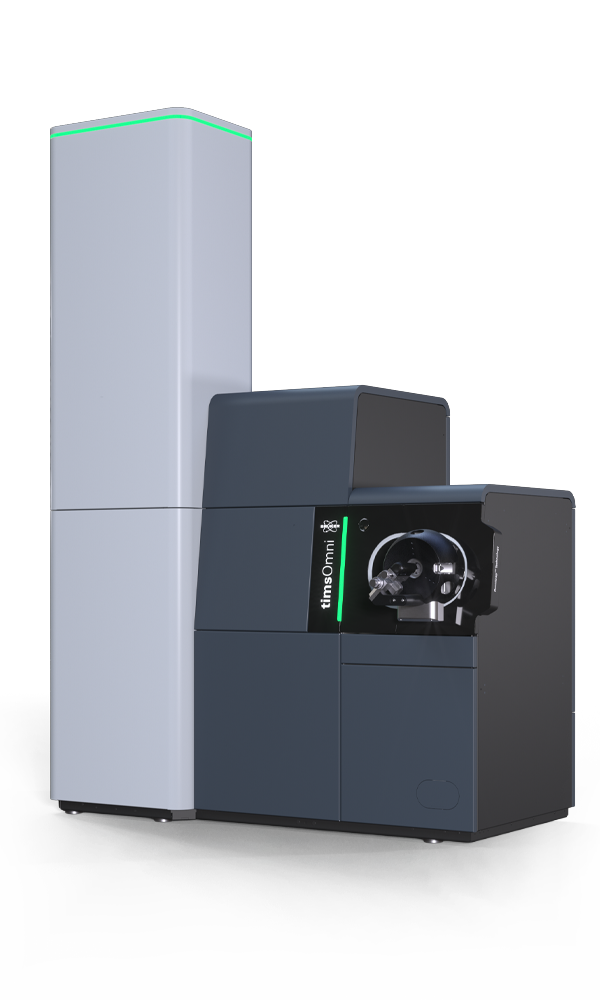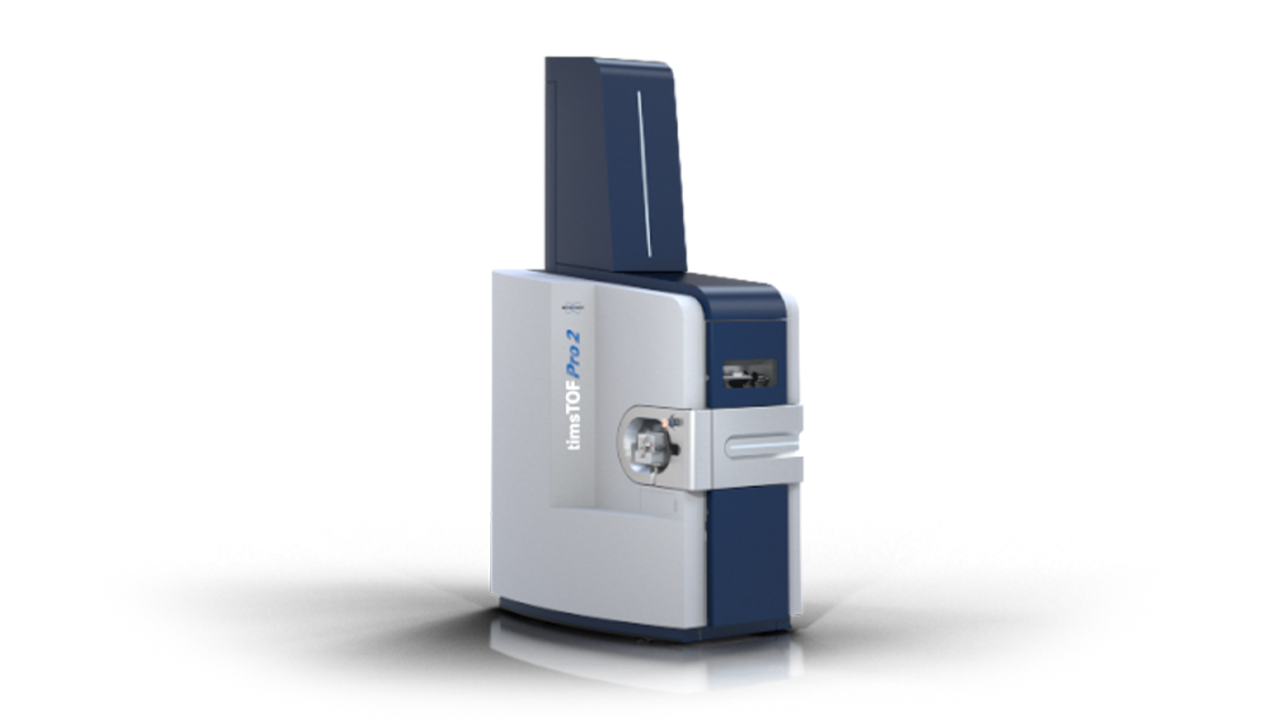timsOmni™
An eXtreme leap
In deep proteoform sequencing and advanced structural elucidation


An eXtreme leap with electron-based fragmentation for deep proteoform sequencing
Introducing the timsOmni™
Leverage advanced structural elucidation and deep proteoform sequencing with MSn eXd coupled to the power of TIMS. timsOmni™ features a unique blend of technology to deliver maximum versatility:
- TIMS for accurate CCS values to determine conformational heterogeneity
- Collision-induced unfolding to explore the conformational landscape of biomolecules
- Precise control of electron-based fragmentation for detailed molecular profiling
- Omnidirectional MSn combined with ion accumulation for unmatched sensitivity
- Trapped eXd mode for optimal precursor utilization, boosting fragment ion yield
- Utilization of all PASEF® modes for bottom-up proteomics and multiomics
Experience Unparalleled MS and MSn sensitivity
timsOmni™ features unparalleled full scan MS and MSn sensitivity through omnidirectional MSn and precursor enrichment for signal amplification of the lowest abundance ions.
By precise modulation of selected ion packets, any ion irrespective of its intensity, can be targeted for superior electron-based fragmentation. Made possible by the omnidirectional multi-stage MSn eXd workflow.
Precise modulation of electron energy and reaction time
Precisely tune electron energy to investigate various fragmentation regimes and adjust eXd reaction time for optimal results. With access to the entire electron fragmentation landscape, design new solutions toward deep sequencing and structural elucidation.
Trapped eXd
In trapped ion eXd mode, precursor ions are confined and rapidly fragment upon electron irradiation. Adapting the trapping time enables to boost the fragment yield and reach optimal precursor consumption (>90%). This unique capability differs from traditional passthrough electron-based fragmentation techniques.
Top-down proteomics with charge DDA
Charge DDA (cDDA) enables on-the-fly charge-state deconvolution during LC–MS analysis, allowing precise targeting of coeluting proteoforms across a wide dynamic range and eliminates redundant fragmentation of highly abundant species.
By dynamically shifting the isolation window to non-overlapping regions of the m/z spectrum, cDDA significantly reduces chimeric spectra.
Sequencing Antibody Complementarity-Determining regions
Analysing and monitoring antibody levels in both healthy individuals and patients in need of treatment is critical for characterizing the progression of a disease, identifying patients with delayed symptom onset and predicting potential long-term immunity.
- Comprehensive ion sequence ladders are essential to characterize the antibodies’ unique Complementarity-Determining Regions (CDRs). CDRs are the hypervariable loops within the variable domains of the light and heavy chains primarily responsible for an antibody’s selectivity and affinity towards a specific antigen.
- CDR sequencing refers to the process of identifying the exact amino acid sequences within these loops to confirm identity, assess potential mutations, or facilitate antibody
Superior eXd efficiency for CDR sequencing is enabled by:
- High capacity eXd section for storing and processing >10M charges in a single scan
- Bright electron source with fine energy control for fastest eXd reactions
- Precise control of eXd reaction time for maximum precursor ion consumption
- Enhanced signal-to-noise MS2 for maximal sequence coverage
"Proteomics will finally go Protein-Centric by using the timsOmni"
Albert Heck, Ph.D., Distinguished Faculty Professor of Chemistry and Pharmaceutical Sciences, Utrecht University and Scientific Director, Netherlands Proteomics Center, Utrecht, Netherlands
Deep characterization of oligonucleotides in negative ion mode by MSn
DNA and RNA are essential for maintaining cellular homeostasis through their roles in protein translation pathways and gene regulation via epigenetics or interfering RNAs. They have already proven to be valuable drug modalities in several disease areas.
Characterizing endogenous RNA modifications is key to understanding biological processes. However, with a limited number of canonical nucleotides and many isobaric modifications such as methylation, precise sequencing of these molecules remains a challenging task.
Oligonucleotides are negatively charged, and their characterization requires alternative fragmentation techniques. The highly versatile eXd source produces high-energy electrons to form radicals in negative mode via Electron Detachment Dissociation (EDD) and is particularly effective for intact top-down characterization of oligonucleotide therapeutics.
"The timsOmni is our new Swiss-army knife for characterizing the structure and modifications of noncoding DNA, RNA, and oligonucleotide therapeutics."
Valérie Gabelica, Ph.D., Professor, School of Pharmaceutical Sciences, University of Geneva, Geneva, Switzerland
Key to understanding disease – Histone Acetylation
Histones are playing a crucial role in DNA packing and histone acetylation is a key functionality in regulating gene expression by modifying the structure of chromatin.
Understanding histone acetylation is laying ground for understanding cancer, neurogenerative or cardiovascular diseases or metabolic disorders.
High variability of modification sites in histone structures is making sophisticated tools mandatory for reliable assignments, state-of-the-art fragmentation capabilities of the timsOmni™ along with sophisticated algorithms of OmniScape™ software enables high confident positional PTM assignments.
"I am excited about the potential of the timsOmni technology for top-down proteoform characterization. Our initial results demonstrate the versatility of the omnitrap for intact protein structure analysis."
Ole Nørregaard Jensen, Ph.D., Professor, Department of Biochemistry and Molecular Biology, University of Southern Denmark, Odense, Denmark
Advancing the Applied Proteomics field with multimodal and MSn
Bacterial enzymes are transforming industrial processes with their exceptional efficiency, specificity, and cost-effective production.
In food manufacturing, these enzymes enhance fermentation, improve texture and clarify products by breaking down starches, proteins, and pectins.
In pharmaceutical manufacturing, high-efficiency enzymes streamline drug synthesis, resulting in improved yields and higher product quality.
"We use intact protein mass analysis to ensure performance, stability, and consistency of our very diverse protein product portfolio. Introduction of the timsOmni, with its Swiss Army knife versatility, redefines intact mass and top-down analysis with the precision, speed, and confidence needed to provide definitive analytical support in development and production of industrial enzymes."
Anders Michael Bernth Giessing, Ph.D., Science Manager, Novonesis, Lyngby, Denmark
Beyond native MS, deep sequencing and PTM characterization of protein complexes
Understanding how membrane proteins assemble to function in health and disease state is critical for drug development. This necessitates multi-level analysis of protein oligomeric states, subunit interactions, posttranslational modifications, and their binding to ligands and inhibitors.
Make use of the newly developed NEOS-Source designed to enhance offline ESI experiments and unparalleld Top-Down MS performance.
"The ion enrichment mode in the timsOmni will faciliate increased scrutiny of low abundant fragments by MSn to achieve complete characterization for deeper insights"
Abraham Oluwole, Postdoctoral Researcher, Carol Robinson lab, University of Oxford, UK
Advanced Structural Elucidation of Small Molecules with MSn eXd
Where is the chlorine? Aromatic chlorines are not reactive and are found in many drugs, while benzylic chlorines are potent alkylating reagents for DNA and proteins, rendering them carcinogenic.
Locating the position of chlorination in trace impurities is critical as benzylic chlorines must be strictly controlled to minimize mutagenicity.
The timsOmni™ goes beyond currently available MSn CID and MS2 EID activation methods, addressing such questions by accessing previously unreachable molecular bonds with MSn eXd.
"In many cases MSn CID or EID cannot resolve the structure of observed impurities. The extremely versatile possibilities the timsOmni provides is a gamechanger and so far has solved every structural problem we have challenged it with, without performing synthesis."
Gustaf Hulthe, Pharmaceutical Technology & Development, AstraZeneca R&D, Gothenburg, Sweden
Monitoring in vivo biotransformation products for improving the efficacy of biotherapeutics
Multispecific antibodies are rapidly emerging as a leading class of biotherapeutics, capable of simultaneously binding to multiple target antigens. These innovative modalities offer novel mechanisms of action, with enhanced efficacy, reduced risk of resistance, and fewer side effects compared to traditional therapies. However, unlike monoclonal antibodies, multispecifics are more prone to degradation in vivo, requiring thorough metabolite characterization.
Top-down and middle-down mass spectrometry (MS) approaches are particularly well-suited for such detailed structural analysis, as bottom-up strategies often fall short in capturing the complete proteoform landscape. Compounding this challenge is the extremely low abundance of these metabolites in in vivo samples, which makes their analysis especially difficult. The introduction of the timsOmni™ marks a significant advancement, ushering in a new era for the comprehensive characterization of multispecific antibody modalities.
Detection of very low abundance biotransformation products, ranging from 3 to 30 nM, is essential for investigating the in vivo stability of next generation biotherapeutics.
"The timsOmni delivers unmatched sensitivity and sequencing power - key to decoding multispecific antibody metabolites"
Julia Chamot-Rooke, Ph.D. CNRS Senior Scientist, Head of the Mass Spectrometry for Biology Unit at Institut Pasteur, Paris, France
研究用にのみ使用できます。臨床診断には使用できません。




